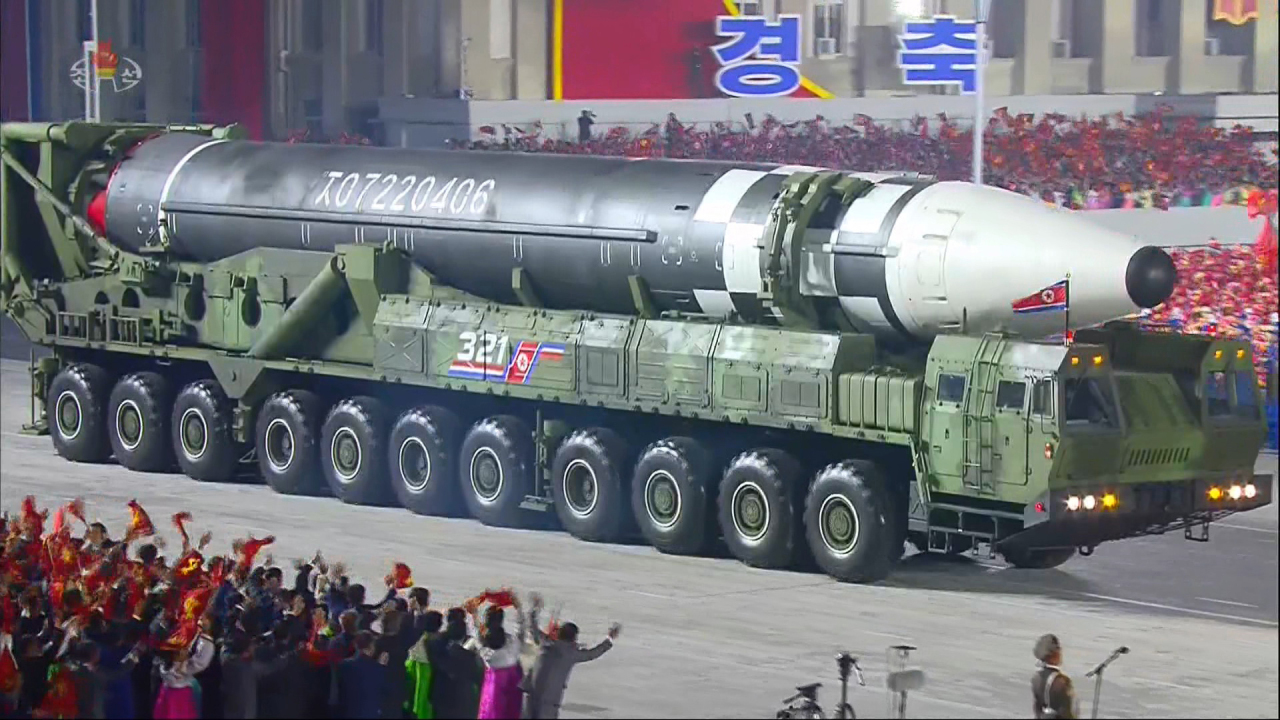N. Korea's new missile looks 'monstrous' but will it work?
Pyongyang unveils what could be world’s biggest ICBM in massive military parade
By Ahn Sung-miPublished : Oct. 11, 2020 - 16:21

North Korea unveiled a gigantic new missile along with other weapons during a rare predawn military parade Saturday, with national leader Kim Jong-un promising to build up the country’s “war deterrence.”
The new weapon, which if it became operational, would be the world’s largest road-mobile, liquid-fueled intercontinental ballistic missile, was the highlight of the carefully choreographed military parade held at Kim Il-sung Square in the center of Pyongyang to mark the 75th anniversary of the ruling Workers’ Party’s founding.
Following the military parade, South Korea’s Cheong Wa Dae convened an emergency meeting of its National Security Council on Sunday morning, to discuss the new weapons and implications of North Korean leader Kim Jong-un’s speech.
“Various accords between the South and the North for the prevention of bilateral armed clashes and war must be kept to at any cost,” Cheong Wa Dae said in a press statement. As to the new strategic weapons unveiled at the parade, the NSC officials said it will continue to analyze the strategic meaning and specifics, while examine the country’s defense capability in preparation.
The new ICBM appears to be an advanced version of the Hwasong-15, Pyongyang’s most powerful tested missile, experts said, although it is unclear whether it is ready to be put to the test anytime soon.
As the Hwasong-15, tested in November 2017, can already strike the US mainland, the new weapon appears to be more focused on the payload, they said.
Michael Elleman, director for Non-Proliferation and Nuclear Policy at the International Institute for Strategic Studies, estimated on Twitter that the new missile could deliver a payload of 2,000-3,500 kilograms to any point in the continental US, greater than the 1,000 kilograms Hwasong-15 is capable of delivering within the same range.
While it is not clear whether the ICBM displayed in the parade would actually work, the North in the past has showcased prototypes at parades and eventually tested them.
“The new ICBM is a monster. Much larger than the Hwasong-15,” Melissa Hanham, deputy director of the Vienna-based Open Nuclear Network, told Nikkei Asia. “But historically they show off design models long before testing.”
The new missile was mounted on a transporter erector launcher with 22 wheels, indicating that it is longer than the Hwasong-15, which was carried by an 18-wheel TEL. The missile appears to be 25-26 meters long and 2.5-2.9 meters in diameter -- about 4-4.5 meters longer and about 5 centimeters wider in diameter than the Hwasong-15, according to the 38 North, a US-based think tank focused on North Korea.
Also unveiled on Saturday was a new submarine-launched ballistic missile called the Pukguksong-4, according to the footage. It appears to be bigger than its predecessor the Pukguksong-3, which the country test-fired in October 2019.
The military parade took place after midnight and lasted about three hours, but was not broadcast by state media until Saturday evening. Past parades in the North usually took place during the day.
Kim, wearing a light gray suit, took center stage at the parade, vowing to strengthen the country’s “war deterrence” to “deter, control and manage” threats from hostile forces, including their “aggravating nuclear threat,” during his 25-minute speech.
But Kim stressed that the country’s military deterrent would only be used in self-defense, and “will never be abused or used as a means for preemptive strike.”
The leader, however, avoided directly mentioning the US and signaled a willingness to “join hands” with South Korea after the current pandemic subsides.
The Unification Ministry, in charge of inter-Korean affairs, expressed hopes that Kim’s message wishing Seoul a fast recovery from the COVID-19, may lead to peace on the Korean Peninsula and improvement in inter-Korean relations.
Following the speech, Kim watched as thousands of troops marched in formation and conventional artillery and massive military hardware rolled through Kim Il-sung Square. He saluted as fighter jets launched flares and fireworks to form the Workers’ Party’s symbol and the number 75 in the sky.
The massive military parade and the public display of weapons show that the communist regime has continued to strengthen its missile and weapons systems all this time, even as the North has engaged in denuclearization diplomacy with Washington.
“When North Korea was more engaged in diplomacy in 2018-2019, it exercised some restraint by not featuring ICBMs in public displays. But all the while the Kim regime has been further developing nuclear weapons and the means to deliver them,” Leif-Eric Easley, a professor at Ewha University in Seoul, told The Korea Herald.
He added that the unveiling of an upgraded SLBM and a larger ICBM qualifies as the new strategic weapon Kim warned the world about early this year amid a stalemate in denuclearization negotiations with the US.
“North Korea continues to improve and expand its firepower that can raise the stakes for the future negotiations,” Easley said.
“The North is delivering its message to the US ahead of the presidential election, showing the country’s military force, saying it is ready to either negotiate or provoke depending on what the US’ stance is,” said Yang Moo-jin, a professor at the University of North Korean Studies in Seoul. “Through the parade, the North showcased its new military capabilities without overstepping any international red lines by actual testing.”
The intelligence authorities in Seoul and Washington are closely analyzing the North’s new weapons.
The US called it “disappointing” to see North Korea continue to prioritize its prohibited nuclear and ballistic missile programs.
“The US remains guided by the vision President (Donald) Trump and Chairman Kim (Jong-un) set forth in Singapore and calls on the DPRK to engage in sustained and substantive negotiations to achieve complete denuclearization,” a US official said, abbreviating the North’s official name, the Democratic People’s Republic of Korea.
The Defense Ministry here voiced concern about the North’s unveiling of a new long-range ballistic missile, but said it took note of Kim’s remark that he would not use its strategic weapons preemptively. It also called on Pyongyang to fully implement the Sept. 19 bilateral military agreement signed in 2018, and work together to reduce military tensions.
By Ahn Sung-mi (sahn@heraldcorp.com)

















![[KH Explains] Hyundai's full hybrid edge to pay off amid slow transition to pure EVs](http://res.heraldm.com/phpwas/restmb_idxmake.php?idx=652&simg=/content/image/2024/04/18/20240418050645_0.jpg&u=20240418181020)

![[Today’s K-pop] Zico drops snippet of collaboration with Jennie](http://res.heraldm.com/phpwas/restmb_idxmake.php?idx=642&simg=/content/image/2024/04/18/20240418050702_0.jpg&u=)